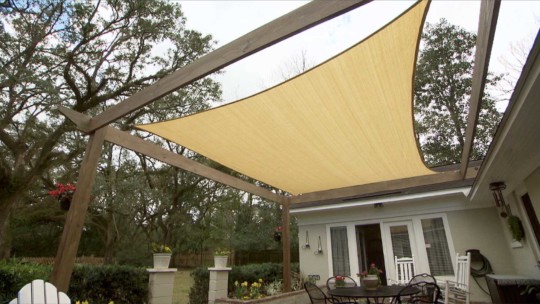Want to divert water from your roof and home in a unique, creative way? If so, you might want to learn how to install a rain chain. Their functional, beautiful, and sometimes inspirational or whimsical forms are sure to start conversations.
What’s a Rain Chain?
You don’t have to live in the Amazon Rainforest to experience your fair share of rain in an average year. Gutter systems—a series of vertical, horizontal, and angled tubes—are typically made of lightweight aluminum. Although they’re functional, they most certainly are not beautiful.
The last legs of any gutter system are vertical pipes known as downspouts. Rain chains replace them completely, running from the top of the gutter to the ground below, and either carrying water off in the same direction as the downspout did, or culminating in a basin. Rain chains employ any number of closely-spaced objects in a row, turning a pedestrian location of your home into an eye-catching water feature.
How Rain Chains Work
Rain chains produce a brilliant effect, using the laws of gravity and a little thing called surface tension. As rainwater flows down your roof and through the gutter, it naturally follows its lowest point, which is the opening to your downspout. Instead of disappearing into the abyss, rainwater collects at the first object in the chain and begins to trickle downward, filling up one object and spilling down to the rest. Of course, that describes just one type of rain chain you can employ. There are many to choose from.
Rain chains aren’t infallible. Although they work best in average, light-to-medium rainfall, a heavy summer downpour will overtake the rain chain’s limited capacity for water displacement. It should be noted that—unless your home’s gutters are capable of handling the water load in your region—no system’s quite perfect.
Rain Chain Installation
While the process of putting in a rain chain is simple, the options are endless. But, before installing one, be sure that rain flow moves naturally away from your home and not toward its foundation.
Removing the downspout is a simple enough task, requiring only the removal of a few screws and brackets. Your rain chain should have some type of fastening mount that allows it to be secured to the newly-opened hole in the gutter.
Make sure to measure the distance between your gutters and the ground, and have a plan for where you want the rain to go. For some homeowners, that may be culminating in a rain barrel or large basin.
Water-friendly plants like liriope (monkey grass) planted around the splash area, as well as river rock, can help orient the water flow.
Big Box or DIY?
Rain chains are traditionally constructed from copper, which, over time, oxidizes to create a brownish, rustic patina. (And, you thought the rain chain itself was charming to behold!)
The cost of copper can be prohibitive, and—like everything in the backyard—cheaper, creative, DIY solutions are abound. Discarded teacups, utensils, and aluminum cookie cutters are just a few examples of the myriad objects that might be collecting dust, but can be repurposed to instead collect water.
Why use Rain Chains?
Rain chains and traditional downspouts aim to do the same thing: divert water away from your home’s foundation. Although there’s nothing wrong with time-tested downspouts, rain chains really add charm. Also, a bit of whimsy, and a touch of your personality.
Who says the sun has to come out when rain offers so much to look forward to?
Other Rainy Projects
If you want a few more options, check out our tips for French Drain installation. A French Drain helps you to manage excess surface or groundwater. Or maybe you’d rather create a rain garden that embraces all the rain you get. Not sure how much rain you’re getting? Learn how to use a rain gauge to measure the rainfall you’re experiencing.



